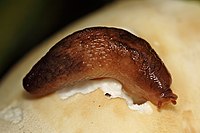
Anti-inflammatory activity of the sclerotia of edible fungus, Poria cocos Wolf and their active lanostane triterpenoids
Sign Up to like & getrecommendations! Published in 2017 at "Journal of Functional Foods"
DOI: 10.1016/j.jff.2017.02.012
Abstract: Abstract Poria cocos Wolf confers large, edible sclerotia, known as ‘Indian bread’ in North America. Chemical investigation of EtOH extract of the sclerotia of P. cocos resulted in the identification of four new lanostane triterpenoids… read more here.
Keywords: anti inflammatory; sclerotia; poria cocos; cocos wolf ... See more keywords

Evaluation of Sulfur-Based Biostimulants for the Germination of Sclerotium cepivorum Sclerotia and Their Interaction with Soil.
Sign Up to like & getrecommendations! Published in 2022 at "Journal of agricultural and food chemistry"
DOI: 10.1021/acs.jafc.2c05862
Abstract: White rot is an economically significant disease of Allium crops. The pathogen Sclerotium cepivorum produces long-lived sclerotia that germinate in response to sulfur-containing compounds released from Allium roots. Diallyl disulfide (DADS) was the primary organic… read more here.
Keywords: sclerotium cepivorum; sclerotia; sulfur; germination ... See more keywords

Incidence of white mould of bean and characterization of its causal pathogen, Sclerotinia sclerotiorum in Kashmir valley, India
Sign Up to like & getrecommendations! Published in 2023 at "Archives of Phytopathology and Plant Protection"
DOI: 10.1080/03235408.2023.2213396
Abstract: Abstract White mould caused by Sclerotinia sclerotiorum affects the quality and quantity of bean crop. The aims of this study were to evaluate the incidence and severity of white mould disease in four districts of… read more here.
Keywords: white mould; incidence; sclerotinia sclerotiorum; sclerotia ... See more keywords

First report of southern blight of Dendrobium huoshanense caused by Sclerotium rolfsii in Lu'an, China.
Sign Up to like & getrecommendations! Published in 2022 at "Plant disease"
DOI: 10.1094/pdis-03-22-0586-pdn
Abstract: Dendrobium, the second largest genus of Orchidacea, are mainly distributed in Asia, Oceania and Europe (Ding et al., 2008). An emerging disease on D. huoshanense with symptoms resembling southern blight Sclerotium rolfsii Sacc. occurred during… read more here.
Keywords: rolfsii; sclerotia; sclerotium rolfsii; huoshanense ... See more keywords

First report of Southern blight, caused by Athelia rolfsii (syn. Sclerotium rolfsii Sacc.), on Hellebores in North America.
Sign Up to like & getrecommendations! Published in 2021 at "Plant disease"
DOI: 10.1094/pdis-09-21-2004-pdn
Abstract: Lenten rose (Hellebores hybridus) is an herbaceous perennial grown in landscapes and valued for early spring flowers and high levels of deer resistance. An additional benefit as a landscape plant comes from the high level… read more here.
Keywords: sclerotia; rolfsii; first report; north america ... See more keywords

Inoculum potential of Sclerotinia sclerotiorum sclerotia depends on isolate and host plant
Sign Up to like & getrecommendations! Published in 2018 at "Plant Pathology"
DOI: 10.1111/ppa.12843
Abstract: The soilborne fungus Sclerotinia sclerotiorum infects many important crop plants. Central to the success of this pathogen is the production of sclerotia, which enables survival in soil and constitutes the primary inoculum. This study aimed… read more here.
Keywords: sclerotia; production; plant; sclerotiorum ... See more keywords

Armillaria mellea Symbiosis Drives Metabolomic and Transcriptomic Changes in Polyporus umbellatus Sclerotia
Sign Up to like & getrecommendations! Published in 2022 at "Frontiers in Microbiology"
DOI: 10.3389/fmicb.2021.792530
Abstract: Sclerotia, the medicinal part of Polyporus umbellatus, play important roles in diuresis and renal protection, with steroids and polysaccharides as the main active ingredients. The sclerotia grow and develop only after symbiosis with Armillaria sp.… read more here.
Keywords: umbellatus sclerotia; sclerotia; polyporus umbellatus; group ... See more keywords